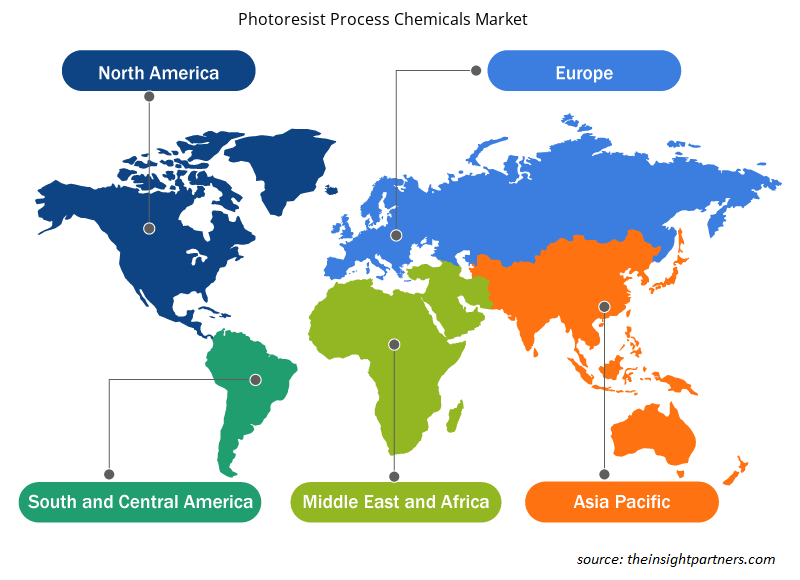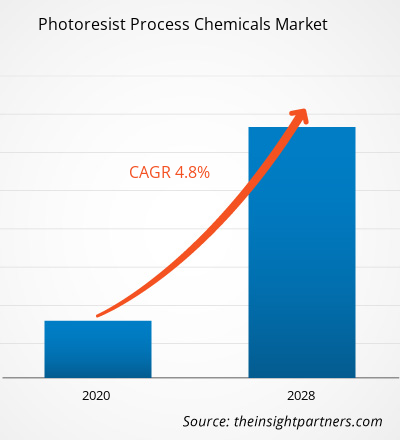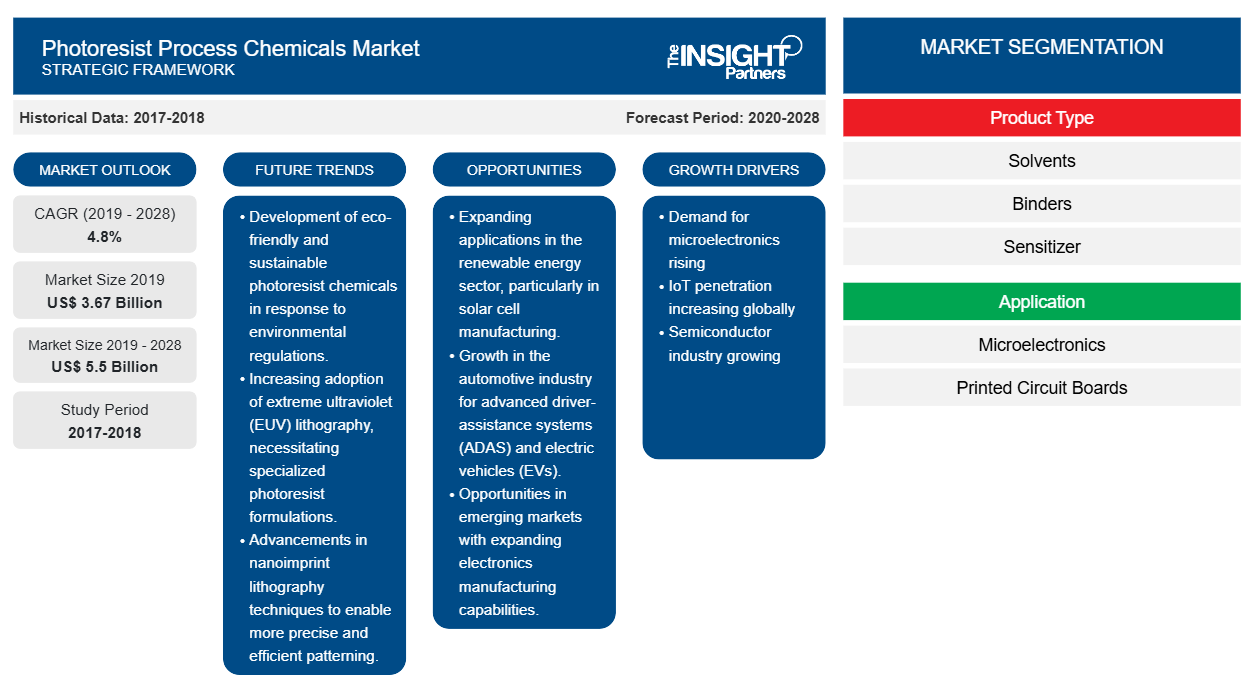Il mercato dei prodotti chimici per il processo fotoresist è stato valutato a 3.665,31 milioni di dollari nel 2019 e si prevede che crescerà a un CAGR del 4,8% nel periodo 2020-2028 per raggiungere 5.495,02 milioni di dollari entro il 2028.
I prodotti chimici di processo per fotoresist sono utilizzati nella produzione di strutture µm e sub-µm, in modo evidente nel settore della microelettronica. I prodotti chimici di processo per fotoresist comprendono solventi, sviluppatori, solventi, stripper e miscele di incisione e sono considerati una parte fondamentale per la realizzazione di circuiti stampati ad alte prestazioni e chip semiconduttori. La crescita del mercato globale dei prodotti chimici di processo per fotoresist è guidata dalla domanda continua e costante di microelettronica dovuta alla crescente domanda di articoli elettronici nei paesi in via di sviluppo e alla crescente penetrazione dell'IoT in tutto il mondo. Inoltre, fattori come la crescente domanda di tecnologia di visualizzazione dinamica e l'eccessiva R&S nei prodotti chimici di processo per fotoresist e nei settori di utilizzo finale stanno spingendo la crescita del mercato globale dei prodotti chimici di processo per fotoresist
Nel 2019, l'Asia Pacifica ha contribuito alla quota maggiore nel mercato globale dei prodotti chimici per i processi fotoresistenti. Si prevede inoltre che l'Asia Pacifica sarà il mercato in più rapida crescita per i prodotti chimici per i processi fotoresistenti nei prossimi anni. L'Asia Pacifica è il continente più grande del mondo ed è noto per il suo mercato espanso di prodotti chimici. La regione è stata notata come uno dei mercati di spicco per l'utilizzo di fotoresistenti e accessori per fotoresistenti; pertanto, offre opportunità redditizie per la crescita del mercato. La Cina sta dominando il mercato regionale, seguita da Giappone, Taiwan, Vietnam, Corea, Thailandia, Malesia e Indonesia. Questi paesi stanno riscontrando una crescente domanda da parte di semiconduttori e circuiti integrati, LCD, circuiti stampati e altri produttori. I prodotti chimici per i processi fotoresistenti sono ampiamente utilizzati nella produzione di fotoresistenti, che vengono ulteriormente utilizzati in dispositivi indossabili, smartphone e altri dispositivi elettronici. Insieme a un cambiamento negli standard di vita dei consumatori, la domanda di smartphone e dispositivi indossabili è aumentata successivamente con la crescita dell'industria elettronica. Questo cambiamento ha dato impulso alla crescita del mercato dei prodotti chimici per la lavorazione della fotoresist nella regione.
La pandemia di COVID-19 sta influenzando negativamente le economie e le industrie in vari paesi a causa di lockdown, divieti di viaggio e chiusure aziendali. Inoltre, i divieti di viaggio globali imposti dai paesi in Europa, Asia e Nord America stanno ostacolando le collaborazioni aziendali e le opportunità di partnership. Tutti questi fattori stanno ostacolando l'industria chimica e dei materiali, che sta frenando la crescita del mercato dei prodotti chimici di processo fotoresistenti.
Personalizza questo report in base alle tue esigenze
Riceverai la personalizzazione gratuita di qualsiasi report, comprese parti di questo report, o analisi a livello nazionale, pacchetto dati Excel, oltre a usufruire di grandi offerte e sconti per start-up e università
-
Scopri le principali tendenze di mercato in questo rapporto.Questo campione GRATUITO includerà analisi di dati che spaziano dalle tendenze di mercato alle stime e alle previsioni.
Approfondimenti di mercato
Crescita dell'industria dei semiconduttori
I recenti progressi tecnologici hanno aumentato l'importanza dei semiconduttori in vari settori verticali dell'industria. Da componente principale dell'elettronica di consumo e delle periferiche, hanno anche assistito a un aumento della domanda da parte del settore automobilistico negli ultimi anni. Dopo aver assistito a un calo nei numeri delle vendite nel 2019, l'industria dei semiconduttori ha registrato una crescita positiva dei ricavi nel 2019 nonostante i problemi causati dalla pandemia di COVID-19 che ha portato l'economia mondiale a un arresto.
Inoltre, i semiconduttori sono un'unità integrante della tecnologia che ci circonda e rafforzano le innovazioni tecnologiche. Forniscono le tecnologie essenziali ai gadget di uso quotidiano come televisori, computer e dispositivi mobili. I prodotti chimici di processo del fotoresist sono utilizzati nella produzione di semiconduttori per la fotolitografia. La fotolitografia è stata il principale motore nella ricerca per ottenere la massima riduzione delle dimensioni di gadget e dispositivi. Per questo motivo, i prodotti chimici di processo del fotoresist hanno anche assistito a un aumento della domanda in tutto il mondo. Alcune aziende hanno anche pianificato di espandere la loro produzione di fotoresist per soddisfare la crescente domanda dell'industria dei semiconduttori. Ad esempio, a febbraio 2021, Sumitomo Chemical ha annunciato l'espansione della sua capacità produttiva di fotoresist per processi avanzati di semiconduttori, tra cui l'immersione in fluoruro di argon (ArF) e la litografia ultravioletta estrema (EUV), installando nuove linee di produzione nel suo stabilimento di Osaka (Konohana-ku, Osaka, Giappone). L'azienda prevede di avviare le operazioni entro il 2022.
Informazioni sul tipo di prodotto
In base al tipo di prodotto, il mercato globale dei prodotti chimici per il processo di fotoresist è suddiviso in solventi, leganti, sensibilizzanti e altri. Il segmento dei solventi ha guidato il mercato con la quota maggiore nel 2019. Un fotoresist è anche noto come resist ed è un'applicazione fotosensibile utilizzata in diversi processi, come la fotolitografia e la fotoincisione, principalmente per creare un rivestimento modellato su una superficie.photoresist process chemicals market is segmented into solvents, binders, sensitizer, and others. The solvents segment led the market with the largest share in 2019. A photoresist is also known as a resist, and it is a light-sensitive application utilized in several processes, such as photolithography & photoengraving, mainly to create a patterned coating on a surface.
Approfondimenti sulle applicazioni
In base all'applicazione, il mercato globale dei prodotti chimici per il processo di fotoresist è segmentato in microelettronica, circuiti stampati e altri. Nel 2019, il segmento della microelettronica ha rappresentato la quota maggiore del mercato. I dispositivi microelettronici sono costituiti da micro dispositivi semiconduttori, transistor, condensatori, resistori e chip attivi. Sono ampiamente utilizzati in apparecchi elettronici di consumo come smartphone, lettori musicali ed elettrodomestici, nonché in altri processi industriali. A questo scopo vengono utilizzati solventi fotoresist, sensibilizzanti, polimeri e altri prodotti chimici. Le crescenti applicazioni nei settori medico, automobilistico ed elettronico hanno aumentato la domanda di componenti microelettronici, il che supporta la crescita del mercato dei prodotti chimici per il processo di fotoresist.
Tokyo Ohka Kogyo Co., Ltd.; Tokuyama Corporation; Dupont; Integrated Micro Materials; Allresist Gmbh; Microchemicals Gmbh; Dischem Inc; ENF TECHNOLOGY CO., LTD.; Sumitomo Chemical Co., Ltd; e Prolyx Microelectronics Private Limited sono tra i principali attori del mercato che operano nel mercato dei prodotti chimici per i processi fotoresistenti. Queste aziende offrono i loro prodotti in tutto il mondo, il che le aiuta a soddisfare una base di clienti più ampia. Questi principali attori del mercato sono fortemente concentrati sullo sviluppo di prodotti innovativi e di alta qualità per soddisfare le esigenze del cliente. Negli ultimi anni, le aziende che operano nel mercato hanno realizzato l'immenso potenziale relativo al mercato dei prodotti chimici per i processi fotoresistenti e sono state fortemente coinvolte in strategie come fusioni e acquisizioni e lancio di prodotti. Ad esempio, nel 2019, Photoresist Stripper SVD e SH5 sono stati lanciati da Microchemicals Gmbh. Questi stripper rimuovono in modo efficiente strati di fotoresist da substrati inorganici come silicio, vetro e metalli.
Segnala i riflettori
- Tendenze industriali progressive nel mercato globale dei prodotti chimici per il processo fotoresist per aiutare gli operatori a sviluppare strategie efficaci a lungo termine
- Strategie di crescita aziendale adottate dai mercati sviluppati e in via di sviluppo
- Analisi quantitativa del mercato globale dei prodotti chimici per il processo di fotoresist dal 2018 al 2028
- Stima della domanda di prodotti chimici per il processo di fotoresist in vari settori industriali
- Analisi PEST per illustrare l'efficacia degli acquirenti e dei fornitori che operano nel settore per prevedere la crescita del mercato
- Sviluppi recenti per comprendere lo scenario competitivo del mercato e la domanda di prodotti chimici per il processo di fotoresist
- Tendenze e prospettive di mercato, insieme ai fattori che guidano e frenano la crescita del mercato dei prodotti chimici per il processo fotoresist
- Processo decisionale mediante la comprensione delle strategie che sostengono l'interesse commerciale in relazione alla crescita del mercato globale dei prodotti chimici per il processo fotoresist
- Dimensioni del mercato dei prodotti chimici per il processo di fotoresist nei vari nodi del mercato
- Panoramica dettagliata e segmentazione del mercato globale dei prodotti chimici per il processo fotoresist nonché delle sue dinamiche nel settore
- Dimensioni del mercato dei prodotti chimici per il processo di fotoresist in varie regioni con promettenti opportunità di crescita
Approfondimenti regionali sul mercato dei prodotti chimici per il processo di fotoresist
Le tendenze regionali e i fattori che influenzano il mercato dei prodotti chimici di processo per fotoresist durante il periodo di previsione sono stati ampiamente spiegati dagli analisti di Insight Partners. Questa sezione discute anche i segmenti e la geografia del mercato dei prodotti chimici di processo per fotoresist in Nord America, Europa, Asia Pacifico, Medio Oriente e Africa e Sud e Centro America.

- Ottieni i dati specifici regionali per il mercato dei prodotti chimici per il processo di fotoresist
Ambito del rapporto di mercato sui prodotti chimici di processo fotoresistenti
| Attributo del report | Dettagli |
|---|---|
| Dimensioni del mercato nel 2019 | 3,67 miliardi di dollari USA |
| Dimensioni del mercato entro il 2028 | 5,5 miliardi di dollari USA |
| CAGR globale (2019 - 2028) | 4,8% |
| Dati storici | 2017-2018 |
| Periodo di previsione | 2020-2028 |
| Segmenti coperti |
Per tipo di prodotto
|
| Regioni e Paesi coperti |
America del Nord
|
| Leader di mercato e profili aziendali chiave |
|
Attori del mercato dei prodotti chimici per il processo di fotoresist Densità: comprendere il suo impatto sulle dinamiche aziendali
Il mercato dei prodotti chimici per processi fotoresistenti sta crescendo rapidamente, spinto dalla crescente domanda degli utenti finali dovuta a fattori quali l'evoluzione delle preferenze dei consumatori, i progressi tecnologici e una maggiore consapevolezza dei vantaggi del prodotto. Con l'aumento della domanda, le aziende stanno ampliando le loro offerte, innovando per soddisfare le esigenze dei consumatori e capitalizzando sulle tendenze emergenti, il che alimenta ulteriormente la crescita del mercato.
La densità degli operatori di mercato si riferisce alla distribuzione di aziende o società che operano in un particolare mercato o settore. Indica quanti concorrenti (operatori di mercato) sono presenti in un dato spazio di mercato in relazione alle sue dimensioni o al valore di mercato totale.
Le principali aziende che operano nel mercato dei prodotti chimici per il processo fotoresist sono:
- Società per azioni Tokyo Ohka Kogyo Co., Ltd.
- Società Tokuyama
- Dupont
- Micro Materiali Integrati
- Allresist GmbH
Disclaimer : le aziende elencate sopra non sono classificate secondo un ordine particolare.

- Ottieni una panoramica dei principali attori del mercato dei prodotti chimici per il processo fotoresist
Mercato dei prodotti chimici per il processo di fotoresist, per tipo di prodotto
- Solventi
- Leganti
- Sensibilizzante
- Altri
Mercato dei prodotti chimici per il processo di fotoresist, per applicazione
- Microelettronica
- Circuiti stampati
- Altri
Profili aziendali
- Società per azioni Tokyo Ohka Kogyo Co., Ltd.
- Società Tokuyama
- Dupont
- Micro Materiali Integrati
- Allresist GmbH
- Microchimica GmbH
- Dischem Inc
- ENF TECHNOLOGY CO., LTD.
- Società chimica Sumitomo, Ltd.
- Prolyx Microelettronica privata a responsabilità limitata
- Analisi storica (2 anni), anno base, previsione (7 anni) con CAGR
- Analisi PEST e SWOT
- Valore/volume delle dimensioni del mercato - Globale, Regionale, Nazionale
- Industria e panorama competitivo
- Set di dati Excel
Report recenti
Rapporti correlati
Testimonianze
Motivo dell'acquisto
- Processo decisionale informato
- Comprensione delle dinamiche di mercato
- Analisi competitiva
- Analisi dei clienti
- Previsioni di mercato
- Mitigazione del rischio
- Pianificazione strategica
- Giustificazione degli investimenti
- Identificazione dei mercati emergenti
- Miglioramento delle strategie di marketing
- Aumento dell'efficienza operativa
- Allineamento alle tendenze normative























 Ottieni un campione gratuito per - Mercato dei prodotti chimici per il processo di fotoresist
Ottieni un campione gratuito per - Mercato dei prodotti chimici per il processo di fotoresist